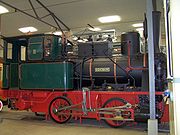
Maschinenfabrik Christian Hagans
Encyclopedia

Erfurt
Erfurt is the capital city of Thuringia and the main city nearest to the geographical centre of Germany, located 100 km SW of Leipzig, 150 km N of Nuremberg and 180 km SE of Hannover. Erfurt Airport can be reached by plane via Munich. It lies in the southern part of the Thuringian...
, Germany, by Christian Hagans.
By the mid-1860s, the company had started building locomotive boilers and other components; in 1872 the first locomotive
Locomotive
A locomotive is a railway vehicle that provides the motive power for a train. The word originates from the Latin loco – "from a place", ablative of locus, "place" + Medieval Latin motivus, "causing motion", and is a shortened form of the term locomotive engine, first used in the early 19th...
followed, a narrow gauge
Narrow gauge
A narrow gauge railway is a railway that has a track gauge narrower than the of standard gauge railways. Most existing narrow gauge railways have gauges of between and .- Overview :...
engine for a rail gauge
Rail gauge
Track gauge or rail gauge is the distance between the inner sides of the heads of the two load bearing rails that make up a single railway line. Sixty percent of the world's railways use a standard gauge of . Wider gauges are called broad gauge; smaller gauges, narrow gauge. Break-of-gauge refers...
of 750 mm. As a result of shortages of space, Hagans often had to limit its operations. For example, the T 15 was built by Henschel because Hagans did not have the necessary capacity. In 1903 the factory site was moved to Ilversgehofen north of the city; only then was large-scale production possible.
On 30 June 1915 the locomotive factory was sold, with effect from 1 April 1916, to the Maschinenbau R. Wolf Magdeburg-Buckau. In 1928, steam locomotive
Steam locomotive
A steam locomotive is a railway locomotive that produces its power through a steam engine. These locomotives are fueled by burning some combustible material, usually coal, wood or oil, to produce steam in a boiler, which drives the steam engine...
manufacture finally came to an end in Erfurt. By then Hagans had built 1,251 locomotives. The last Hagans engine was a DRG Class 64
DRG Class 64
The Deutsche Reichsbahn had a standard passenger train tank engine with a wheel arrangement of 1'C1' or 2-6-2 and a low axle load, which was designated in their classification system as the DRG Class 64 . The Class 64 was developed from 1926 onwards and it was built between 1928 and 1940...
.
Hagans locomotive
A type of articulated steam locomotiveArticulated locomotive
Articulated locomotive usually means a steam locomotive with one or more engine units which can move independent of the main frame. This is done to allow a longer locomotive to negotiate tighter curves...
is named after Hagans. It had two groups of coupled wheels that moved together and which were connected via swinging lever system (Schwinghebelsystem), so that the locomotive managed with one pair of cylinders.
Examples are the Baden VIII d, the Prussian T 13
Prussian T 13
The Prussian T 13 was a series of tank locomotives built in large numbers for the various German state railways, notably the Prussian state railways, and the Deutsche Reichsbahn during the early part of the 20th century.- T 13 :...
and the Prussian T 15.
Preserved locomotives
- ČSD U 36.003 (ex Göllnitztalbahn No. 3) with the Kindereisenbahn Košice (in regular operation)
- HOHEMARK No.2 in the Frankfurt am Main Transport Museum
89 7462 DB museum Koblenz
Literature
- Hagans, Friedrich; Lohr, Hermann; Thielmann, Dr. Georg: Lokomotiven von Hagans, Transpress, Berlin 1991, ISBN 9783344004736
- Karl-Ernst Maedel: Aus der Dampfzeit: Erinnerungen und Erzählungen aus einer vergangenen Epoche, München 1999, Geramond, ISBN 3932785983
External links
- http://www.werkbahn.de/eisenbahn/lokbau/hagans.htm
- Firmen-Geschichte der Fa. Hagans
- There is a relevant English-language forum at Railways of Germany

